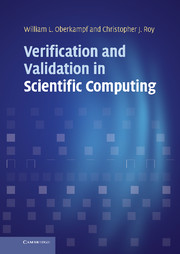Book contents
- Frontmatter
- Contents
- Preface
- Acknowledgments
- 1 Introduction
- Part I Fundamental concepts
- Part II Code verification
- Part III Solution verification
- 7 Solution verification
- 8 Discretization error
- 9 Solution adaptation
- Part IV Model validation and prediction
- Part V Planning, management, and implementation issues
- Appendix Programming practices
- Index
- Plate Section
- References
9 - Solution adaptation
from Part III - Solution verification
Published online by Cambridge University Press: 05 March 2013
- Frontmatter
- Contents
- Preface
- Acknowledgments
- 1 Introduction
- Part I Fundamental concepts
- Part II Code verification
- Part III Solution verification
- 7 Solution verification
- 8 Discretization error
- 9 Solution adaptation
- Part IV Model validation and prediction
- Part V Planning, management, and implementation issues
- Appendix Programming practices
- Index
- Plate Section
- References
Summary
The previous chapter focused on the estimation of numerical errors and uncertainties due to the discretization. In addition to estimating the discretization error, we also desire methods for reducing it when either it is found to be too large or when the solutions are not yet in the asymptotic range and therefore the error estimates are not reliable. Applying systematic mesh refinement, although required for assessing the reliability of all discretization error estimation approaches, is not the most efficient method for reducing the discretization error. Since systematic refinement, by definition, refines by the same factor over the entire domain, it generally results in meshes with highly-refined cells or elements in regions where they are not needed. Recall that for 3-D scientific computing applications, each time the mesh is refined using grid halving (a refinement factor of two), the number of cells/elements increases by a factor of eight. Thus systematic refinement for reducing discretization error can be prohibitively expensive.
Targeted, local solution adaptation is a much better strategy for reducing the discretization error. After a discussion of factors affecting the discretization error, this chapter then addresses the two main aspects of solution adaptation:
methods for determining which regions should be adapted and
methods for accomplishing the adaption.
- Type
- Chapter
- Information
- Verification and Validation in Scientific Computing , pp. 343 - 368Publisher: Cambridge University PressPrint publication year: 2010



